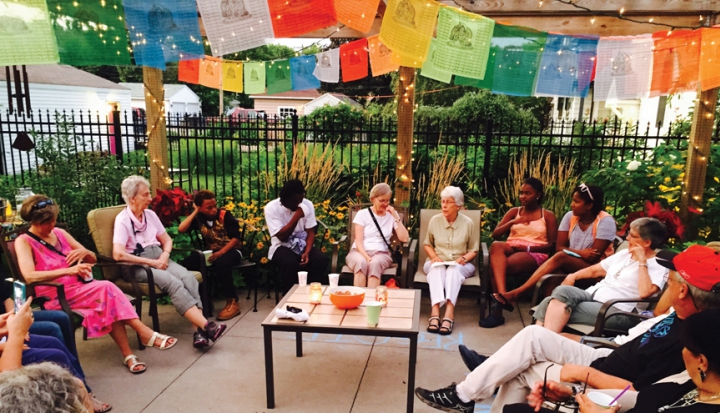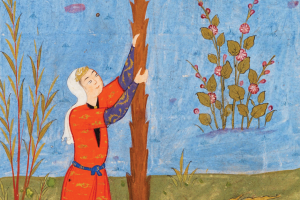It looks like just another house on just another block in just another American neighborhood. Tidy hostas line the walkway to the front door, pretty wicker chairs are circled on the front porch, and the doorbell chimes in a familiar four-note melody.
The sweet-faced, gray-haired women who answer the door look familiar, too: They might be AARP members, someone’s great aunts, or even just friendly next-door neighbors to anyone in any city. They greet callers with warm smiles and understanding nods, sometimes dispense a lemon bar or a glass of water, and love to hear the news about who’s just had a new baby down the block or who’s in from out of town to visit relatives.
But this house sits in one of the most violent, poor, and crime-riddled neighborhoods in Minneapolis, and the six women in it are Visitation sisters living a monastic life in an inner-city setting. The monastery is housed in two typical neighborhood homes a block apart in the Near North area of Minneapolis, a neighborhood that, in crime maps of the city, has one of the highest concentrations of gunshots fired and violent crimes.
The sisters are there to live a spiritual life in an urban setting and to participate in a community of people who are often marginalized or overlooked.
They are, as their neighbors fondly call them, “nuns in the hood.”
Monastic life
Most monasteries are peaceful refuges, withdrawn from interruptions and distractions, city congestion, and, often times, other people. Monastics tend to renounce worldly goods and draw away from the secular world in order to embrace the spiritual one within their secluded cloisters.
This North Minneapolis monastery has its roots in 17th-century France, where St. Francis de Sales and St. Jane de Chantal founded the Visitation order. The order takes its name from the Visitation of Mary to her cousin Elizabeth and bases its tenets on the virtues of the Virgin making that visit: gentleness, simplicity, humility, patience, optimism, respect, and interiority. Salesian spirituality is based on de Sales’ belief that everyone is called to be holy, that relating to and helping others are devout callings, and that living daily life doing ordinary things can be passionately spiritual—without necessarily withdrawing from the world.
There are 11 Visitation monasteries in the United States, and about half of them are traditional and contemplative. The order calls these monasteries the First Federation. Days are spent in scheduled private and group prayer, reading, religious study, and in domestic tasks such as gardening or baking. These monasteries are sometimes housed in stone edifices behind iron gates or in peaceful, pastoral settings apart from cities or towns. The remaining five monasteries, the Second Federation, seek livelier, more constant interaction with their outside communities—like running schools. One of these five is the unique urban monastery in Minneapolis.
Before coming to Minneapolis in 1989, three sisters at the Visitation Academy of St. Louis devoted 10 years to prayer and reflection about what kind of meaningful work they might do. Sister Mary Frances Reis, who joined the other three by praying from her monastery in St. Paul and who now acts as community leader of the Minneapolis monastery, recalls often asking, “Lord, what would you have us do?” The answer, the four founding sisters came to believe, was not to run a treatment center or a school but to be a prayerful, spiritual presence in a marginalized community. “The answer,” Reis says, “was ‘I want you to go and live, and when the doorbell rings, you get your agenda.’ ”
The founding sisters proposed two ideas to the Second Federation leadership. One, says founding member Sister Mary Margaret, was “to do what existing monasteries do, and one was go out to the poor, marginalized, and stressed in the community.”
In 1988 the Second Federation leadership approved the latter, and the four founding sisters moved to Minnesota.
Living in an urban monastery
Many monastic contemplatives are engaged with their own rich spiritual lives that are, well, nearly silent. Not these nuns.
They blog. They tweet. They have a Facebook page. They post YouTube videos.
Committed to the goal of maintaining a prayerful, spiritual presence in their neighborhood, the nuns make themselves visible on social media, at community events, and in everyday interactions with their many neighbors. They organize spiritual retreats for area women and coordinate scholarships to send children to Catholic Youth Camp, an overnight camp in northern Minnesota. They help social service organizations and volunteers connect with North Minneapolis families and people in need by “bridging”—linking services to people and linking those in need with those interested in helping.
But the two homes set a block apart are still a monastery. The nuns awake at 6 a.m. for an hour of prayer and meditation. Then they come together at 7 for morning prayer, where neighbors can join them in chanting psalms and scripture readings. Eucharist is at 8, noon is midday prayer, 4:45 p.m. is evening prayer, and then more time for personal prayer before night prayer at 8:15 p.m.
A sign at the door lets visitors know when they may ring the bell and join the nuns in prayer or ask for help. The sisters say that these incursions to the monastery are not seen as disruptions but as opportunities to meet and welcome Christ. Sister Karen Mohan, a founding member of the monastery, calls those ringing doorbells “punctuation that prepares us to meet Jesus.”
This blend of contemplation and engagement creates a unique sort of monastic life that encourages seeing interruptions as invitations, and it follows the Salesian idea of seeking the presence of God in real persons with real needs.
A spiritual presence in the community
“Being intentional about prayer life goes with us to the door,” says Sister Katherine Mullin, vocations director, who grew up in Minneapolis and has been with the Visitation Monastery in North Minneapolis for 15 years, moving from the Visitation Monastery in St. Paul, which she entered in 1959. Contemplatives are trained in the transcendent, she says, cultivating solitary meditation and prayer while valuing deep inner personal awareness that hopefully manifests as stability and calm. The urban monastery is neither a retreat nor a mission, but a space of gentle spirituality and prayer that offers listening and reflection to neighbors who live in violence and hardship.
Today at the door it’s Justin, a blonde teenager who has been coming to see the sisters since he was about 4 years old. He’s in need of “three eggs”—not two, not four—for an omelet. He sees a bowl set out on a table for a visitor. “Are those nuts?” he asks. Two of the sisters speak gently to him, and he gets a hug before one brings him into the kitchen. The hungry boy leaves carrying eggs and a bag of nuts.
A man stops by and asks for bus tokens so he can travel downtown to a hospital to offer reassurance to a young gunshot victim. The man and the nuns begin to talk, and soon he’s opening up about his marital troubles—his wife uses too many credit cards, and there’s a problem with her spending. The nuns listen and then pray with him.
Another man wants to share his thoughts about the racial tensions in the city, including the July 2016 shooting of Philando Castile across the river and about six miles away in Falcon Heights, a suburb of St. Paul.
Sometimes the visitor at the door is new to the monastery. Many times it is an old friend—a new father that the sisters have known since he was 4 years old, a young teen who says “these women helped raise me,” a mother who has known the sisters for years.
“I heard about you,” says a first-time visitor. “You don’t have much, but you share what you’ve got.”
People come to the door for practical help, but they also come to talk, to pray, to open up about what is particularly hard about life that day. “It’s little things,” says Sister Mary Margaret. “But little things are really big things.” Treating each visitor with great respect, learning and honoring their life story, praying together, and very often, laughing together, even when the circumstances are hard—these “little things” are the essential components of the nuns’ Salesian spirituality.
The urban monastic approach the sisters practice is to simply be present. To live in the neighborhood, to be in community with the neighbors, and to consider these interactions to be their work. Where some monasteries might bake bread or grow herbs or care for the sick or even teach school, these nuns make sacred ground in the inner city by being caring and gentle neighbors in a sometimes uncaring and violent part of town.
The needs of this community are daunting and urgent, and its pain is palpable. In May 2016, the fatal drive-by shooting of a woman sitting in her car made headlines. In July 2016, another drive-by killed one toddler and wounded another. Addiction, abuse, grinding poverty, and violence are not abstract concepts here but daily life challenges and gritty realities.
A friend of the sisters, Carolyn Brooks, says, “Having been born and raised here, I can say that it’s not like it used to be. When I hear about our people killing and being killed—” she pauses for a moment and wipes her eyes, and other visiting neighbors listening to her nod. “It used to be fists and yelling, but now it’s knives, guns, banging on doors at night, drive-bys.”
Balancing chaos and calm
This is not the environment that initially seems conducive to attempting to live an introspective life. But the sisters seem to transmute that chaos around them by treating each visitor who comes to the door with great respect and care, listening to their story, and responding to it with unconditional, nonjudgmental acceptance. “The people who come to the door are changing us,” says Sister Karen. “They reveal the face of Christ.”
However, “these women are no fools, they know what’s going on, they know what we face,” says a neighbor, Dianna Bady, a mother of a blended family of nine children. “These sisters are coming from a good place. They love us to death.”
The sisters do not have much to give—they can spare a bus token or a $10 card for the grocery store. Some days it feels frustrating to not have more to give, to not have more power to right the very large wrongs around them, and to have such human limitations of resources and time.
“Sometimes we are very stretched,” acknowledges Sister Katherine. “But isn’t everyone in the world?”
They set appropriate boundaries. The children of the neighborhood are always eager to come to the house with the kind ladies who share cookies and listen so calmly, but a houseful of children is far from peaceful. A creative solution to protecting prayer time was reached: A colorful windsock is hung outdoors whenever the sisters are free to talk, play, or offer snacks. When the windsock goes up, little people are at the door. Those relationships begun with preschoolers have lasted into adulthood, and now the children of children who visited the nuns are ringing the bell.
Many of the parents in the community are deeply appreciative. Over the years the nuns have worked with other social organizations and individuals to help get services and goods to families in need.
For the mothers, the nuns created a Mother’s Day gift to the community: a day-long women’s retreat that offers a chance for some 50 neighborhood women—Hispanic, Asian, Native American, and African American—to get to know each other over a meal and a day of talking and sharing.
“We realized that the neighbors trusted us, but not each other,” says Sister Katherine. “We thought if they could just get together and meet each other . . .”
Dianna nods. “Growing up as an African American, you’re not as trusting of people. If it wasn’t for you [the sisters], we wouldn’t know each other.”
A vision for the future
Slowly, the original four founding sisters grew to six and then, recently, seven.
Brenda Lisenby was a Baptist missionary, moving between Hong Kong and China for 20 years before coming to the Minneapolis Visitation Monastery in 2014 as a monastic immersion experience resident. Some monasteries offer such residencies to laypeople as ways to learn about the order or live the contemplative life for a short period of time. Last May Brenda entered the novitiate to begin a two-year formation. At the end of those two years, she will make first profession and then become a vowed sister.
Her days follow the regimen of contemplation and prayer with the rest of the sisters, but she particularly focuses on reading and studying for “spiritual formation”—spiritual education, deepening, and growth. She devotes morning hours to prayer and reflection, but then heads downstairs “to see what needs doing.” Today she answers the door to a young man needing something to eat and bus tokens. She fixes him a sandwich, gets him his tokens, and talks with him while he eats.
“I think that is the beauty of living in a real house, not in a traditional monastic building,” says Brenda. “There is no institutional feel, only the welcome of a front porch, a backyard, a home garden. It is not intimidating and allows us to welcome those who might never feel comfortable in a traditional monastic setting.”
An urban monastery can combine the stability and balance of a monastic life with the social action and ministry of apostolic life, and this blend intrigues her. “I value hospitality and inclusiveness,” says Brenda. “What I value about this urban monastery is the integration of contemplative prayer and action. Because we are not cloistered in the traditional sense—our monastery garden being the neighborhood—we are able to be present to our neighbors and share our home and prayer with them. Because we are not living behind walls, we are approachable, accessible, and only a doorbell ring away.” Further, on the monastery’s website, she writes, “I am thinking that monastic communities of the 21st century will bear little resemblance to the monastic communities of [early] Christendom. Even traditional apostolic communities are looking for new ways to be community and finding new ways of belonging that opens the doors for a more ecumenical inclusiveness.”
The 27-year-old Minneapolis Visitation Monastery is currently updating its long-range plan, which they do every three years. Rather than imposing actions on the monastery from the top down, the sisters are interviewing their constituents—their neighbors—to find out what they need, which monastery activities help them most, and what else they require. The monastery’s back-to-school party, where children fill backpacks with donated school supplies, is highly praised because it allows families to stretch exhausted resources to provide for their children. Also popular is a Christmas program in which the sisters have adults fill out wish lists, share them with a local donor organization, and then help distribute goods back to the families.
The “nuns in the hood” speak warmly about how the community in which they live has changed and enriched them. But even the youngest of the neighbors recognize the effect on the community of proximity to lives lived in quiet contemplation and spirituality.
Sister Mary Margaret tells a story of one day when she was swinging outside with a very young boy from the neighborhood. “When you move . . .” he began.
“Oh, we’re not moving,” she said. “We are here to stay.”
“When you move,” he began again.
And again she reassured him that the sisters were not going to move away.
“When you move,” he said patiently, and Sister Mary Margaret then decided to let him speak. “When you move, things will have been better because you were here.”
This article also appears in the January 2017 issue of U.S. Catholic (Vol. 82, No. 1, pages 25–29).
Image: Courtesy of Melissa Borgmann-Kiemde













Add comment